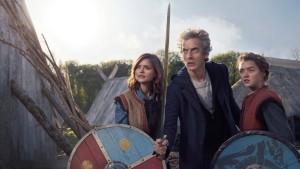 “The Girl Who Died” is the fifth episode of Season 9 of Doctor Who and the first part of the third two-parter this season. After saving Clara who is floating in space with a spider of some sort in the suit, they land on Earth and are taken hostage by a group of Vikings. They are taken to the Viking village where a group of powerful aliens known as The Mire take all the Viking warriors and Clara and a girl name Ashildr. Ashildr antagonizes the Mire, and commits her village to do battle with them the next day. This leaves the Doctor and Clara with just one day to train a village of non-fighters to battle one of the most powerful warrior races in the galaxy.
“The Girl Who Died” is the fifth episode of Season 9 of Doctor Who and the first part of the third two-parter this season. After saving Clara who is floating in space with a spider of some sort in the suit, they land on Earth and are taken hostage by a group of Vikings. They are taken to the Viking village where a group of powerful aliens known as The Mire take all the Viking warriors and Clara and a girl name Ashildr. Ashildr antagonizes the Mire, and commits her village to do battle with them the next day. This leaves the Doctor and Clara with just one day to train a village of non-fighters to battle one of the most powerful warrior races in the galaxy.
The plot of this episode is rather a standard in sci-fi/fantasy. A village who can’t defend itself from a more powerful enemy must be trained to fight for themselves by an outside warrior. My one problem with this, is that I’ve never considered the Doctor a warrior. He may fight, but warrior has the ring of professional fighter, and that is not the Doctor. The training goes awry of course. In only a short time, half the village is on fire, and one of the men now faints at just the mention of blood. The Doctor comes up with another solution that is more befitting him, that doesn’t require taking up swords, but instead uses the story telling skills of Ashildr and the Mire’s own technology against them.
I knew the whole question about why the Doctor chose his face would come up eventually. They made such a big deal about it last season, that it had to have some significance, and I knew it had to relate back to the story “Fires of Pompeii.” The Watsonian perspective is what we get in the episode, that the face is to remind him that he can still bend the rules of time and space without breaking any fixed points. It’s his excuse to meddle and find a way to save Ashildr. I don’t mind that so much, especially considering the amount of time that passed between the episode and now, but in universe and in real life. I did like that he considered the consequences of his actions, and that living a long time (not immortal, neither the Doctor or Ashildr are), was a lonely prospect. The line “Immortality isn’t living forever, it’s everyone else dying,” was a perfect way to put it.
I don’t want Game of Thrones, so I have no comment on how similar or dissimilar Ashildr is to the character the actress played on GoT. I did like her for the most part, but would have liked a little more development of her character. I would have preferred to see her be a story-teller than be told. I really liked how the Mire appeared to the Vikings in their village, claiming to be Odin, and appearing in the sky surrounded by clouds, just like a Monty Python animated skit. I was funny, and much more impressive than the Doctor’s yo-yo.
I still don’t care for Clara playing the part of the Doctor. I hate her controlling personality and how she can manipulate him into doing what she wants. She’s been doing it a lot this series, and it’s getting on my nerves. I will not miss Clara when she is gone. I knew the topic of hybrids would come up again, and the Doctor describes Ashildr as one near the end. The Doctor’s ability to “speak” baby was cute back in “Closing Time” and with Stormaggedon, but it’s not that cute anymore. The scenes with the Doctor translating added some nice pathos, but over all, I can do with the baby translation. Go back to speaking cat.
This first part doesn’t end on the usual cliffhanger, with someone in peril. Instead, we see Ashildr’s reaction as she realizes the price of immortality, something she didn’t even want, but must now live with. Part two will deal with those consequences. I do like the idea of a follow-up, but hope that they don’t go down the path of immortality=losing one’s conscience. I want Ashildr to be better than that. I will have to wait and see.

